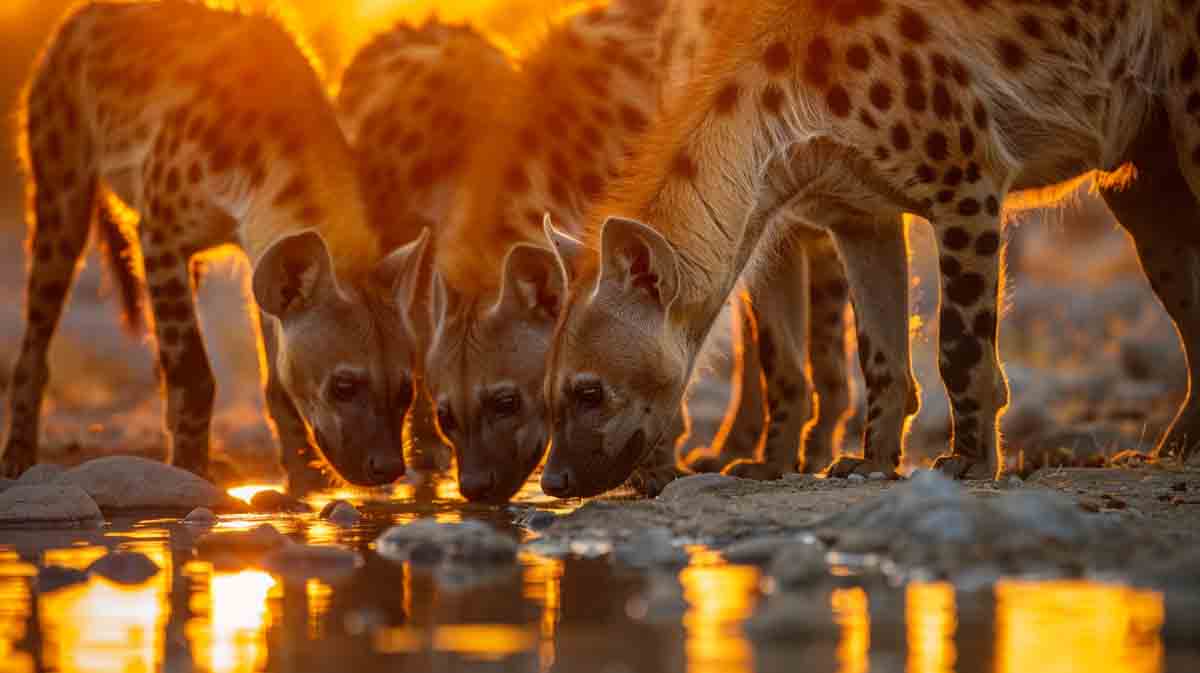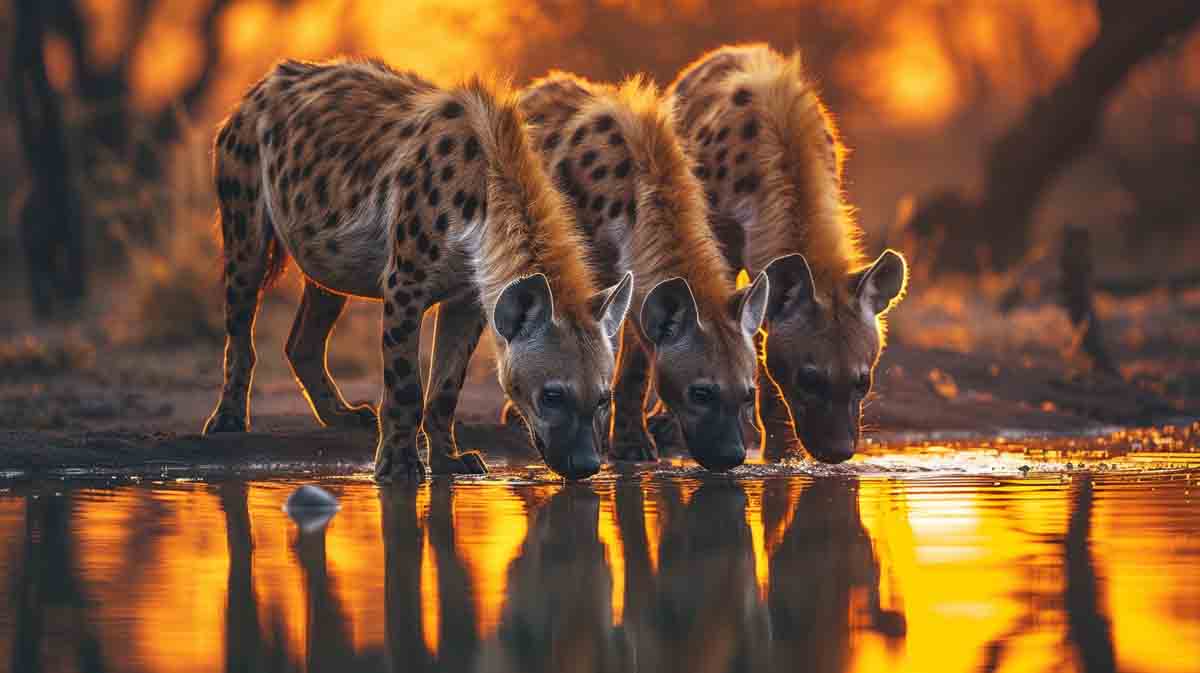Did you know that female spotted hyenas have a pseudo-penis through which they give birth? This surprising fact sets them apart from other hyena species, making their birthing process complex and risky.
Key Takeaways
- Female spotted hyenas have a pseudo-penis through which they give birth.
- The narrow birth canal poses challenges and risks for both the mother and the cubs.
- Approximately 60% of hyena cubs suffocate during birth due to the constricted passage.
- The pseudo-penis serves multiple purposes, including urination, copulation, and giving birth.
- Understanding hyena reproduction provides valuable insights into these fascinating creatures.
Now, let’s delve deeper into the unique process of how hyenas give birth and explore the challenges they face.

How Do Hyenas Give Birth?
Female hyenas, specifically spotted hyenas, give birth through their pseudo-penis, which is an enlarged clitoris. This narrow birth canal, measuring only about one inch across, makes the birthing process difficult and risky.
The size of hyena cubs, combined with the narrow birth canal, often leads to complications during delivery. Approximately 60% of hyena cubs suffocate on their way out due to the constricted passage. This high mortality rate emphasizes the challenges and risks involved in hyena birthing.
The long and agonizing birthing process can last up to 48 hours, and first-time mothers have a higher mortality rate of 9-18%. The female hyena’s pseudo-penis is unique to the species and serves multiple purposes, including urination, copulation, and giving birth.
| Hyena Birth Process and Difficulties | |
|---|---|
| Challenges | Solutions |
| Constricted birth canal | Unique adaptation of a pseudo-penis |
| High mortality rate of cubs | Vigilant care and protection from mothers |
| Agonizing and extended labor | Persistence and endurance |

The Female Hyena’s Pseudo Penis
The female spotted hyena’s pseudo-penis is an extraordinary adaptation that sets these animals apart from other mammals. It is an enlarged clitoris that closely resembles a male’s penis. The pseudo-penis serves multiple functions, including urination, copulation, and giving birth.
During the birthing process, the pseudo-penis expands to accommodate the passage of cubs. However, in some cases, the pseudo-penis tears lead to severe complications and even the death of the mother. This highlights the risks and challenges associated with hyena birthing.
The purpose behind the female hyena’s pseudo-penis has yet to be fully understood. However, several hypotheses aim to explain its presence. One hypothesis suggests that the pseudo-penis acts as a submission signal, conveying social status and enforcing dominance within the hyena social structure.
Another hypothesis proposes that the pseudo-penis is a result of high levels of androgens and testosterone in female hyenas, which have shaped their female-dominant social structure. These hormones may have influenced the evolution of the pseudo-penis as a unique adaptation.

Pseudo Penis Structure and Function
The structure of the female hyena’s pseudo-penis closely resembles a male’s penis, with erectile tissue and a urethra. This allows hyenas to engage in copulation and urinate through the pseudo-penis.
During mating, the female’s pseudo-penis is erect, facilitating the transfer of sperm from the male’s penis. This erection is necessary for successful reproduction and the continuation of the species.
While the pseudo-penis presents unique challenges during birth, it is a remarkable adaptation that has allowed hyenas to thrive in their environment. It is a testament to the diverse and fascinating ways nature shapes and moulds different species.
| Purpose of the Pseudo Penis | Functions |
|---|---|
| Urination | Allows hyenas to urinate through the pseudo-penis. |
| Copulation | Facilitates mating and the transfer of sperm. |
| Birth | Provides a unique birth canal for hyena cubs. |
Conclusion
Hyena birth is a fascinating and unique process that showcases the challenges faced by female spotted hyenas due to their pseudo-penis. The narrow birth canal and the large size of the cubs create risks for both the mother and the offspring, resulting in a high mortality rate. Despite these difficulties, hyenas have evolved particular adaptations to navigate their reproductive cycle.
The pseudo-penis, a distinguishing feature of the species, serves multiple purposes and significantly impacts the birthing process. Its enlargement during labour and potential tearing contribute to the complexity of hyena birth. This distinctive reproductive system sets hyenas apart and provides valuable insights into their reproductive strategies.

Understanding the intricacies of hyena reproduction highlights the challenges these animals face and emphasizes their resilience and adaptability. Hyena’s birth is a testament to the remarkable abilities of these creatures in overcoming reproductive obstacles. Exploring these aspects of hyena reproduction sheds light on their unique place in the animal kingdom and the awe-inspiring wonders of nature.
FAQ
What is the significance of spotting hyena birth in Africa Geographic?
Observing hyena birth in Africa Geographic provides an opportunity to witness the miraculous process of female hyenas giving birth to their cubs in the wild, offering valuable insights into spotted hyenas’ behaviour and life cycle.
Where can I witness a spotted hyena birth in the wild?
Spotted hyena births can be witnessed in the wild, particularly in sub-Saharan Africa. Safaris and visits to national parks like Kruger National Park in South Africa offer the chance to observe these remarkable events.
How many cubs does a female spotted hyena typically give birth to?
A female spotted hyena typically gives birth to around two to four cubs, and these cubs are born with their eyes open, ready to navigate their surroundings in the hyena den.
What is the role of male spotted hyenas during the birth process?
Male spotted hyenas have a lesser role in the birth process and are not typically present during the cubs’ birth. The dominant females within the hyena clan primarily oversee the birthing process and the care of the cubs.
How long is the gestation period for spotted hyenas?
The gestation period for spotted hyenas typically ranges from 12 to 18 months, during which the pregnant hyena may appear agitated and uncomfortable as she prepares to give birth.
What are some signs that a female spotted hyena is about to give birth?
Signs that a female spotted hyena is about to give birth may include the mother becoming increasingly restless, appearing agitated, and seeking a suitable place within the hyena den to start giving birth.
What is the significance of hyena family dynamics during the birthing process?
The relationship between spotted hyenas within a clan and the dynamics of the hyena family are crucial during the birthing process. Dominant females provide support and guidance, while other clan members may assist in guarding the den and ensuring the cubs’ safety.
Are there any risks involved in giving birth to female spotted hyenas?
Giving birth can pose risks for female spotted hyenas, as with any animal giving birth, and the hyena mother may experience challenges such as difficulty in allowing the foetus to pass or complications during the birthing process.
What role do spotted hyena cubs play in the hyena clan?
Spotted hyena cubs play a vital role within the hyena clan, as they are raised and nurtured within the clan structure and contribute to the continuity and strength of the specific hyena family and the overall cohesiveness of the clan.
Who documented the process of spotted hyena birth in Africa Geographic?
Researchers and wildlife photographers, such as Samuel Cox, documented and studied the process of spotted hyena birth in Africa Geographic, providing valuable insights into hyenas’ natural behaviour and biology in their wild habitat.
